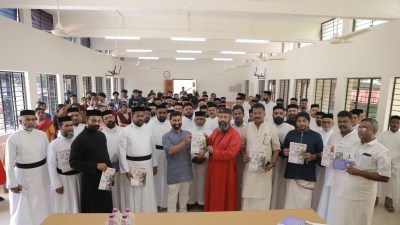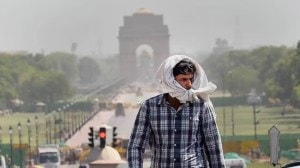- India
- International
Explained: Who is Chhatradhar Mahato, and what does his induction into Trinamool mean?
On February 1 this year, Mahato was released from jail, ending his 11-year spell behind bars. Following his release, he joined the TMC with the party aiming to establish peace in Jangalmahal area.
 Chhatradhar Mahato was the face of Maoist-backed tribal movement of 2008-2011 in Lalgarh
Chhatradhar Mahato was the face of Maoist-backed tribal movement of 2008-2011 in Lalgarh
West Bengal Chief Minister Mamata Banerjee recently inducted Chhatradhar Mahato into the Trinamool Congress. Mahato, the face of the Maoist-backed tribal movement of 2008-2011 in Lalgarh, was freed on bail a few months ago after spending almost 11 years in jail.
In the run-up to the West Bengal Assembly elections, Mahato’s induction in the TMC has attracted a lot of attention. A look at this political development in the context of Mahato’s background.
Attack on Buddhadeb and police action
On November 2, 2008, then West Bengal chief minister Buddhadeb Bhattacharjee and then central ministers Ram Vilas Paswan and Jitin Prasada had a narrow escape in a landmine blast at Salboni in West Midnapore district. CPI (Maoist) had taken the responsibility of the explosion triggered in protest against the setting up of a steel plant on tribal land.
In the aftermath of the assassination attempt, the West Bengal Police carried out raids across the Lalgarh area in the district, the epicentre of the Maoist movement at the time, and allegedly began atrocities on tribal villagers. On November 4, three school boys, studying between Class 8 and 10, were picked up by the Lalgarh police for being suspected Maoists.
Police action resulted in villagers forming a committee called Police Santras Birodhi Janosadharan Committee (PSBJC) or People’s Committee against Police Atrocities. PSBJC became a frontal organisation of the Maoists that instigated the tribal uprising against the state government from 2008 to 2009.

Chhatradhar Mahato, brother of Maoist leader Sashadhar Mahato, who was the principal accused in the assassination attempt on the chief minister, was the convenor of PSBJC.
📣 Express Explained is now on Telegram. Click here to join our channel (@ieexplained) and stay updated with the latest
Mahato and the Lalgarh movement
PSBJC activists led by Chhatradhar Mahato blocked roads, shut off police access to Lalgarh area and attacked CPI(M) leaders and workers, resulting in bloodshed in the Maoist-dominated Jangalmahal area comprising West Midnapore, Purulia, Bankura and Jhargram districts. The movement had support from people in neighbouring districts as well and led to further resentment against the then Left Front regime.
PSBJC continued to mobilise people against the state government with Mahato being the face of the tribal movement.
Mamata Banerjee, who was in the Opposition then, shared the dais with Mahato in 2009. The Trinamool Congress extended its support to the people’s movement against the Left Front government.
The sustained movement saw the first change of power in the 2019 Lok Sabha polls when the TMC and the Indian National Congress coalition won a total of 25 of 42 parliamentary constituencies in West Bengal.
Although the CPI(M) retained the Jhargram Lok Sabha seat, the ripple effects of the tribal movement was felt across the state. In the Lalgarh area, the CPI(M) party offices and houses of leaders were ransacked by the people and many Left leaders were killed.
In June 2009, a month after Lok Sabha polls, Operation Lalgarh was initiated by the West Bengal Police with assistance from the central forces to free Lalgarh from Maoists. The CRPF, COBRA and the BSF (deployed in anti-Naxal operation for the first time) personnel began the operation on June 18.
On Day Four of the operation, social activists and artistes like national award-winning filmmaker Aparna Sen, theatre personality Saoli Mitra and others went to Lalgarh to take stock of the situation and interacted with Chhatradhar Mahato. They appealed to both the state and the Maoists to shun arms and opt for a ceasefire.
Following a 12-day long operation, the joint forces succeeded in reclaiming Lalgarh from the Maoists, forcing rebels, including Mahato, into hiding. Later, the PSBJC launched its military wing — Sidhu Kanu Gana Militia- to combat security forces.
The tribal movement resulted in the deaths of more than 400 CPI(M) workers and leaders, 30 policemen and 18 Maoist leaders.
Also in Explained | Why Sonia Gandhi took so long to acknowledge Narasimha Rao’s contributions
The fall of Mahato
In an undercover operation on September 28 in 2009, policemen posing as journalists seeking to interview Mahato arrested him. He was charged under the Unlawful Activities Prevention Act (UAPA). PSBJC members led by armed Maoists stopped a New Delhi-bound Bhubaneshwar-Rajdhani Express at Jhargram demanding the release of Mahato. They held the train for five hours before CRPF and state police commandos forced them to flee. Recently, the Ministry of Home Affairs (MHA) asked the National Investigation Agency (NIA) to investigate this 11-year-old case.
Chhatradhar Mahato’s brother Sashadhar Mahato was killed in an encounter in March 2011. In May 2011, Mahato contested the state Assembly election as an Independent candidate from jail but bagged only little over 20,000 votes.
Riding on the tribal movement and its anti-land acquisition movements in Singur and Nandigram, the Trinamool Congress ended the 34-year Left Front rule in the state. However, after coming to power, the TMC distanced itself from Mahato and PSBJC members.
Moreover, the TMC government initiated a crackdown of Maoist operations in Jangalmahal area in which CPI(Maoist) Polit Bureau member Koteshwara Rao alias Kishenji was killed in an encounter in the Burisole forest in West Midnapore district in November 2011.
Later, Mahato had held Banerjee responsible for Kishenji’s death in a fake encounter. Following the death of Kishenji, the PSBJC movement in Jangalmahal area fizzled out.
In September 2012, the Calcutta High Court granted the status of political prisoner to Mahato along with 8 other activists. On May 15, the court convicted Mahato under UAPA along with other three PCPA members, Sukhshanti Baske, Sambhu Soren and Sagun Murmu and sentenced life imprisonment.
Saffron surge in Jangalmahal
In 1977, after the first Left Front government came to power in West Bengal, villages in Jangalmahal area were freed from the control of landlords in a land reform exercise, giving freedom to tribals. As a result, the CPI(M) held the Jhargram Lok Sabha seat since 1977 till 2014. The area accounts for 35 per cent tribal voters.
The TMC, in 2014, ended the CPI(M)’s 37-year run in Jhargram Lok Sabha constituency. In 2017, the TMC government also formed Jhargram as a separate district by bifurcating West Midnapore district as an effort to intensify development. However, allegations of corruption against local leaders including the sitting MP and violent panchayat polls in 2018, alienated the ruling party from the people.
The BJP meanwhile did exactly what the TMC did before coming to power in 2011- reaching out to the affected people. The TMC government’s attempts to stop benefits of central government schemes reaching to the tribal people swinged the mood in BJP’s favour.
As a result, the BJP not only won Jhargram Lok Sabha seat but won five out of six seats in Jangalmahal area (tribal land) in 2019 Lok Sabha polls. The saffron surge in tribal-dominated area has forced the ruling Trinamool Congress to look for a prominent face to stop BJP’s success ahead of crucial 2021 state Assembly polls.
TMC banks on Mahato, again
After witnessing the rise of the BJP following the 2018 panchayat polls, the TMC government went soft on Mahato. It did not object to the parole being granted to Mahato and even got him admitted at a private hospital for treatment. His son Dhritiprasad Mahato was given a Group D job at a cooperative bank in Lalgarh.
On February 1 this year, Mahato was released from jail, ending his 11-year spell behind bars. Following his release, he joined the TMC with the party aiming to establish peace in Jangalmahal area.
Mahato was inducted into the TMC’s state committee last week. According to party leaders, Mahato has been asked to work at the grassroots to win the support of the tribals in TMC’s favour and consolidate the votebank.
More Explained
EXPRESS OPINION
Apr 26: Latest News
- 01
- 02
- 03
- 04
- 05










































